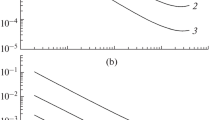Abstract
In thermodynamic analysis of solutions of oxygen in Fe–Co melts containing carbon, the equilibrium constants of reactions between carbon and oxygen are determined, as well as the activity coefficients at infinite dilution and the interaction parameters in melts of different composition at 1873 K. The dependence of oxygen solubility in such melts on the cobalt and carbon content is calculated. In iron–cobalt melts, carbon has high oxygen affinity. The deoxidizing ability of carbon increase significantly with increase in cobalt content in the melt. In pure cobalt, it is more than an order of magnitude greater than in pure iron. Deoxidation by carbon produces gaseous oxides: carbon monoxide (CO) and dioxide (CO2). The reaction of carbon and oxygen dissolved in the melt and hence the deoxidizing ability of carbon depend on the total gas pressure above the melt. Decrease in gas pressure significantly improves the reducing properties of carbon. The minimum oxygen concentration for alloys of the same composition is reduced by practically an order of magnitude with tenfold decrease in the total gas pressure. The gas composition above Fe–Co melts and the equilibrium carbon and oxygen concentrations in the melt are calculated with total gas pressures of 1.0, 0.1, and 0.01 atm. The optimal oxygen concentration (1–10 ppm) in Fe–Co melts is reached at carbon concentrations between 0.01 and 1% depending on the total gas pressure (0.01–1 atm). The solubility of oxygen in iron–cobalt melts containing carbon passes through a minimum, which is shifted to lower carbon content with increase in the melt’s cobalt content. Further additions of carbon increase the oxygen concentrations in the melt. With increase in cobalt content, this increase will be sharper.
Similar content being viewed by others
References
Zhukhovitskii, A.A. and Shvartsman, L.A., Fizicheskaya khimiya (Physical Chemistry), Moscow: Metallurgizdat, 1963.
Wagner, C., Thermodynamics of Alloys, Cambridge MA: Addison-Wesley, 1952.
Grigoryan, V.A., Belyanchikov, L.N., and Stomakhin, A.Ya., Teoreticheskie osnovy elektrostaleplavil’nykh protsessov (Theoretical Principles of Electric Steelmaking Processes), Moscow: Metallurgiya, 1987.
Karasev, R.A. and Samarin, A.M., On carbon and oxygen activity in iron–carbon–oxygen melts, Izv. Akad. Nauk SSSR, Otd. Tekh. Nauk, 1953, no. 8, pp. 1130–1136.
Steelmaking Data Sourcebook, New York: Gordon & Breach, 1988.
Sigworth, G.K. and Elliott, J.F., The thermodynamics of dilute liquid cobalt alloys, Can. Metall. Quart., 1976, vol. 15, no. 2, pp. 123–127.
Kulikov, I.S., Raskislenie metallov (Deoxidation of Metals), Moscow: Metallurgiya, 1975.
Frohberg, M.G. and Wang, M., Thermodynamic properties of sulphur in liquid copper-antimony alloys at 1473 K, Z. Metallkd., 1990, vol. 81, no. 7, pp. 513–518.
Katsnelson, A.V., Dashevskiy, V.Ya., and Kashin, V.I., Carbon activity in Fe-, Co-, Ni-and Mn-based melts at 1873 K, Steel Res., 1993, vol. 64, no. 4, pp. 197–202.
Dashevskii, V.Ya., Aleksandrov, A.A., Kanevskii, A.G., and Makarov, M.A., Solubility of oxygen in carboncontaining Fe–Ni Melts, Rare Met., 2009, vol. 28, pp. 383–387.
Hultgren, R., Desai, P.D., Hawkins, D.T., Gleiser, M., and Kelley, K.K., Selected Values of the Thermodynamic Properties of Binary Alloys, Metals Park, OH: Am. Soc. Met., 1973.
Furman, I.E., Improvement of composition and methods of casting of cobalt stellites, Cand. Sci. (Eng.) Dissertation, Yekaterinburg: Ural. Gos. Tekh. Univ., 2007.
Gulyaev, A.P., Metallovedenie (Metal Science), Moscow: Metallurgiya, 1986.
Gaponova, O.P. and Budnik, A.F., Stali ta splavi z osoblivimi vlastivostyami (Steels and Alloys with Specific Properties), Sumy: Sums’kii Derzh. Univ., 2014.
Sergeev, V.V. and Bulygina, T.I., Magnitotverdye materialy (Hard Magnetic Materials), Moscow: Energiya, 1980.
Hilzinger, R. and Rodewald, W., Magnetic Materials, Erlangen: Publicis, 2013.
Dashevskii, V.Ya., Aleksandrov, A.A., and Leont’ev, L.I., Thermodynamics of oxygen solutions in the complex reduction of Fe–Co melts, Steel Transl., 2014, vol. 44, no. 5, pp. 337–344.
Author information
Authors and Affiliations
Corresponding author
Additional information
Original Russian Text © A.A. Aleksandrov, V.Ya. Dashevskii, L.I. Leont’ev, 2018, published in Izvestiya Vysshikh Uchebnykh Zavedenii, Chernaya Metallurgiya, 2018, No. 1, pp. 46–53.
About this article
Cite this article
Aleksandrov, A.A., Dashevskii, V.Y. & Leont’ev, L.I. Oxygen Solubility in Fe–Co Melts Containing Carbon. Steel Transl. 48, 11–16 (2018). https://doi.org/10.3103/S0967091218010035
Received:
Published:
Issue Date:
DOI: https://doi.org/10.3103/S0967091218010035



